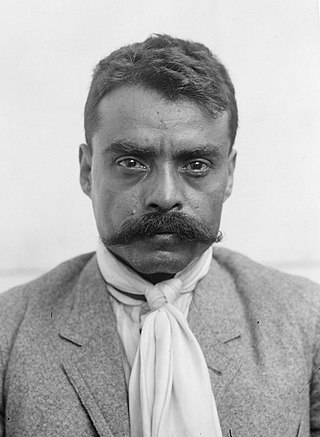
Emiliano Zapata Salazar was a Mexican revolutionary. He was a leading figure in the Mexican Revolution of 1910–1920, the main leader of the people's revolution in the Mexican state of Morelos, and the inspiration of the agrarian movement called Zapatismo.

The United Mexican States is a federal republic composed of 32 federal entities: 31 states and Mexico City, an autonomous entity. According to the Constitution of 1917, the states of the federation are free and sovereign in all matters concerning their internal affairs. Each state has its own congress and constitution.
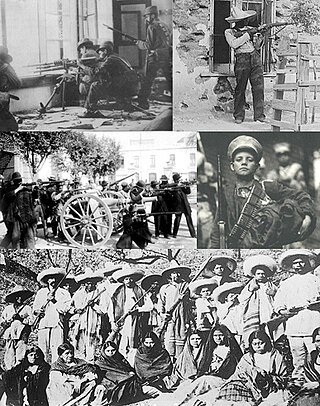
The Mexican Revolution was an extended sequence of armed regional conflicts in Mexico from approximately 1910 to 1920. It has been called "the defining event of modern Mexican history". It resulted in the destruction of the Federal Army and its replacement by a revolutionary army, and the transformation of Mexican culture and government. The northern Constitutionalist faction prevailed on the battlefield and drafted the present-day Constitution of Mexico, which aimed to create a strong central government. Revolutionary generals held power from 1920 to 1940. The revolutionary conflict was primarily a civil war, but foreign powers, having important economic and strategic interests in Mexico, figured in the outcome of Mexico's power struggles. The United States played an especially significant role.

Morelos, officially the Free and Sovereign State of Morelos, is one of the 32 states which comprise the Federal Entities of Mexico. It is divided into 36 municipalities and its capital city is Cuernavaca.

The State of Mexico, officially just Mexico, is one of the 32 federal entities of the United Mexican States. Commonly known as Edomex to distinguish it from the name of the whole country, it is the most populous, as well as the most densely populated, state in the country.

A constituent assembly is a body assembled for the purpose of drafting or revising a constitution. Members of a constituent assembly may be elected by popular vote, drawn by sortition, appointed, or some combination of these methods. Assemblies are typically considered distinct from a regular legislature, although members of the legislature may compose a significant number or all of its members. As the fundamental document constituting a state, a constitution cannot normally be modified or amended by the state's normal legislative procedures in some jurisdictions; instead a constitutional convention or a constituent assembly, the rules for which are normally laid down in the constitution, must be set up. A constituent assembly is usually set up for its specific purpose, which it carries out in a relatively short time, after which the assembly is dissolved. A constituent assembly is a form of representative democracy.
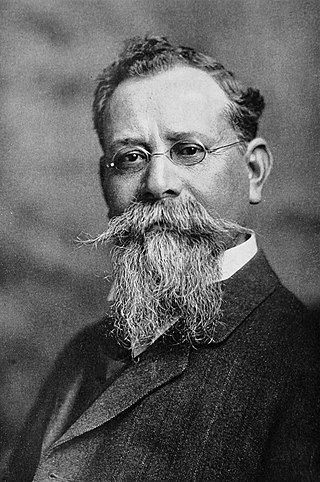
José Venustiano Carranza de la Garza was a Mexican wealthy land owner and politician who was Governor of Coahuila when the constitutionally elected president Francisco I. Madero was overthrown in a February 1913 right-wing military coup.

Quintana Roo is a state in southeast Mexico established out of the Quintana Roo Territory in 1974 with seven municipalities, which has since grown into eleven municipalities. According to the 2020 Mexican census, it has the twenty-fourth largest population of all states with 1,857,985 inhabitants and is the 19th largest by land area spanning 44,705.2 square kilometres (17,260.8 sq mi).

Cuautla, officially La heroica e histórica Cuautla, Morelos or H. H. Cuautla, Morelos, is a city and municipality in the Mexican state of Morelos, about 104 kilometers south of Mexico City. In the 2010 census the city population was 154,358. The municipality covers 153.651 km2 (59.325 sq mi). Cuautla is the third most populous city in the state, after Cuernavaca and Jiutepec. The city was founded on April 4, 1829. The 2020 population figures were 187,118 inhabitants for the municipality and 157,336 inhabitants for the city of Cuatula.

Chiapas is a state in Southwest Mexico. According to the 2020 Mexican Census, it has the eighth largest population of all states with 5,543,828 inhabitants and the 10th largest by land area spanning 73,560.47 square kilometres (28,401.86 sq mi). Chiapas is officially divided into 124 municipalities, although the establishment of municipal authorities in Belisario Domínguez was suspended in 2015 pending the resolution of a territorial dispute between Chiapas and the neighbouring state of Oaxaca. In 2021, the Mexican Supreme Court resolved this dispute in Oaxaca's favour, and annulled the 2011 decree that had created Belisario Domínguez.

Morelos is a state in South Central Mexico that is currently divided into 36 municipalities. According to the 2020 Mexican Census, it is the twenty-third most populated state with 1,971,520 inhabitants and the third smallest by land area spanning 4,878.9 square kilometres (1,883.8 sq mi).

Municipalities are the second-level administrative divisions of Mexico, where the first-level administrative division is the state. They should not be confused with cities or towns that may share the same name as they are distinct entities and do not share geographical boundaries. As of January 2021, there are 2,454 municipalities in Mexico, excluding the 16 boroughs of Mexico City.
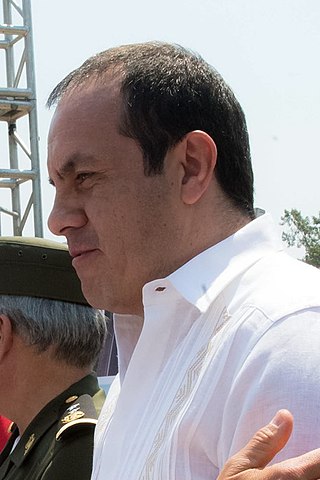
The governor of Morelos, which was created with the state of Mexico in 1869.
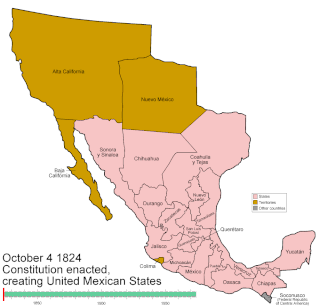
Mexico has experienced many changes in territorial organization during its history as an independent state. The territorial boundaries of Mexico were affected by presidential and imperial decrees. One such decree was the Law of Bases for the Convocation of the Constituent Congress to the Constitutive Act of the Mexican Federation, which determined the national land area as the result of integration of the jurisdictions that corresponded to New Spain, the Captaincy General of Yucatán, the Captaincy General of Guatemala and the autonomous Kingdoms of East and West. The decree resulted in the independence from Spain.

The Constitution of Apatzingán, formally Decreto Constitucional para la Libertad de la América Mexicana, was promulgated on October 22, 1814 by the Congress of Anahuac gathered in the city of Apatzingán because of the persecution of the troops of Félix María Calleja. The constitution was valid for insurgent forces in the territories that it controlled during the Mexican War of Independence.
Same-sex marriage has been legal in Morelos since 5 July 2016. A bill to amend the State Constitution to legalize same-sex marriage in Morelos passed Congress on 18 May 2016 by 20 votes to 6. Ratification by a majority of the state's 33 municipalities was confirmed on 27 June 2016. The law was published in the official state gazette on 4 July 2016 and took effect the following day.

During the Mexican Revolution, from roughly around 1913 to 1917, the peasants from the Mexican region of Morelos established a territory with an alternative political, and economic system. They were heavily influenced by Emiliano Zapata and his ideology of zapatism. The political and economic structure of the territory was militarily supported by the Liberation Army of the South, which was where the army was formed. The commune is also at times compared to the Makhnovshchina in eastern Ukraine, due to their shared structures and ideals.
The Jiménez Territory was a federal territory of Mexico that existed between 1914 and 1917. It was created by the decree of 17 June 1914 issued by the Congress of the United Mexican States that amended articles 43 and 44 of the Constitution of 1857, with the districts of Arteaga, Andrés del Río, Mina, Jiménez, and its capital, Hidalgo del Parral, from the state of Chihuahua; the decree also created the territories of Bravo and Morelos.
The Bravo Territory was a federal territory of Mexico that existed between 1914 and 1917. It was created by the decree of 17 June 1914 issued by the Congress of the United Mexican States which amended articles 43 and 44 of the Constitution of 1857, with the districts of Galeana, Bravos, and a fraction of the district of Iturbide, from the state of Chihuahua; the capital was Ciudad Juárez. The decree also created the territories of Jiménez and Morelos.















